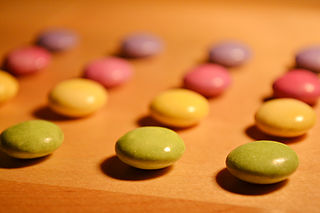
Obsessive–compulsive personality disorder (OCPD) is a cluster C personality disorder marked by a spectrum of obsessions with rules, lists, schedules, and order, among other things. Symptoms are usually present by the time a person reaches adulthood, and are visible in a variety of situations. The cause of OCPD is thought to involve a combination of genetic and environmental factors, namely problems with attachment.

Hoarding disorder (HD) or Plyushkin's disorder, is a mental disorder characterised by persistent difficulty in parting with possessions and engaging in excessive acquisition of items that are not needed or for which no space is available. This results in severely cluttered living spaces, distress, and impairment in personal, family, social, educational, occupational, or other important areas of functioning. Excessive acquisition is characterized by repetitive urges or behaviours related to amassing or buying property. Difficulty discarding possessions is characterized by a perceived need to save items and distress associated with discarding them. Accumulation of possessions results in living spaces becoming cluttered to the point that their use or safety is compromised. It is recognised by the eleventh revision of the International Classification of Diseases (ICD-11) and the Diagnostic and Statistical Manual of Mental Disorders, 5th edition (DSM-5).
Scrupulosity is the pathological guilt/anxiety about moral or religious issues. Although it can affect nonreligious people, it is usually related to religious beliefs. It is personally distressing, dysfunctional, and often accompanied by significant impairment in social functioning. It is typically conceptualized as a moral or religious form of obsessive–compulsive disorder (OCD). The term is derived from the Latin scrupus, a sharp stone, implying a stabbing pain on the conscience. Scrupulosity was formerly called scruples in religious contexts, but the word scruple now commonly refers to a troubling of the conscience rather than to the disorder.

An intrusive thought is an unwelcome, involuntary thought, image, or unpleasant idea that may become an obsession, is upsetting or distressing, and can feel difficult to manage or eliminate. When such thoughts are associated with obsessive-compulsive disorder (OCD), Tourette's syndrome (TS), depression, body dysmorphic disorder (BDD), and sometimes attention-deficit hyperactivity disorder (ADHD), the thoughts may become paralyzing, anxiety-provoking, or persistent. Intrusive thoughts may also be associated with episodic memory, unwanted worries or memories from OCD, post-traumatic stress disorder, other anxiety disorders, eating disorders, or psychosis. Intrusive thoughts, urges, and images are of inappropriate things at inappropriate times, and generally have aggressive, sexual, or blasphemous themes.
The Yale–Brown Obsessive–Compulsive Scale (Y-BOCS) is a test to rate the severity of obsessive–compulsive disorder (OCD) symptoms.
Sexual obsessions are persistent and unrelenting thoughts about sexual activity. In the context of obsessive-compulsive disorder (OCD), these are extremely common, and can become extremely debilitating, making the person ashamed of the symptoms and reluctant to seek help. A preoccupation with sexual matters, however, does not only occur as a symptom of OCD, they may be enjoyable in other contexts.

Compulsive behavior is defined as performing an action persistently and repetitively. Compulsive behaviors could be an attempt to make obsessions go away. Compulsive behaviors are a need to reduce apprehension caused by internal feelings a person wants to abstain from or control. A major cause of compulsive behavior is said to be obsessive–compulsive disorder (OCD). "The main idea of compulsive behavior is that the likely excessive activity is not connected to the purpose to which it appears directed." There are many different types of compulsive behaviors including shopping, hoarding, eating, gambling, trichotillomania and picking skin, itching, checking, counting, washing, sex, and more. Also, there are cultural examples of compulsive behavior.
Animal psychopathology is the study of mental or behavioral disorders in non-human animals.
Primarily obsessional obsessive–compulsive disorder, also known as purely obsessional obsessive–compulsive disorder, is a lesser-known form or manifestation of OCD. It is not a diagnosis in the DSM-5. For people with primarily obsessional OCD, there are fewer observable compulsions, compared to those commonly seen with the typical form of OCD. While ritualizing and neutralizing behaviors do take place, they are mostly cognitive in nature, involving mental avoidance and excessive rumination. Primarily obsessional OCD takes the form of intrusive thoughts often of a distressing, sexual, or violent nature.

Obsessive–compulsive disorder (OCD) is a mental and behavioral disorder in which an individual has intrusive thoughts and feels the need to perform certain routines (compulsions) repeatedly to relieve the distress caused by the obsession, to the extent where it impairs general function.
Adam Scott Radomsky is a Canadian psychologist who studies obsessive-compulsive disorder (OCD) and related anxiety disorders. He is a professor in the Department of Psychology at Concordia University in Montreal, Canada, and was editor-in-chief of the Journal of Behavior Therapy and Experimental Psychiatry.
The biology of obsessive–compulsive disorder (OCD) refers biologically based theories about the mechanism of OCD. Cognitive models generally fall into the category of executive dysfunction or modulatory control. Neuroanatomically, functional and structural neuroimaging studies implicate the prefrontal cortex (PFC), basal ganglia (BG), insula, and posterior cingulate cortex (PCC). Genetic and neurochemical studies implicate glutamate and monoamine neurotransmitters, especially serotonin and dopamine.
The cause of obsessive–compulsive disorder is understood mainly through identifying biological risk factors that lead to obsessive–compulsive disorder (OCD) symptomology. The leading hypotheses propose the involvement of the orbitofrontal cortex, basal ganglia, and/or the limbic system, with discoveries being made in the fields of neuroanatomy, neurochemistry, neuroimmunology, neurogenetics, and neuroethology.
In psychology, relationship obsessive–compulsive disorder (ROCD) is a form of obsessive–compulsive disorder focusing on close or intimate relationships. Such obsessions can become extremely distressing and debilitating, having negative impacts on relationships functioning.
The delayed-maturation theory of obsessive–compulsive disorder suggests that obsessive–compulsive disorder (OCD) can be caused by delayed maturation of the frontal striatal circuitry or parts of the brain that make up the frontal cortex, striatum, or integrating circuits. Some researchers suspect that variations in the volume of specific brain structures can be observed in children that have OCD. It has not been determined if delayed-maturation of this frontal circuitry contributes to the development of OCD or if OCD is the ailment that inhibits normal growth of structures in the frontal striatal, frontal cortex, or striatum. However, the use of neuroimaging has equipped researchers with evidence of some brain structures that are consistently less adequate and less matured in patients diagnosed with OCD in comparison to brains without OCD. More specifically, structures such as the caudate nucleus, volumes of gray matter, white matter, and the cingulate have been identified as being less developed in people with OCD in comparison to individuals that do not have OCD. However, the cortex volume of the operculum (brain) is larger and OCD patients are also reported to have larger temporal lobe volumes; which has been identified in some women patients with OCD. Further research is needed to determine the effect of these structural size differences on the onset and degree of OCD and the maturation of specific brain structures.
The University of Florida Obsessive–Compulsive Disorder Program is a treatment and research clinic in the Department of Psychiatry at the University of Florida. The clinic is located in Gainesville, Florida.

Wayne Goodman is an American psychiatrist and researcher who specializes in Obsessive-Compulsive Disorder (OCD). He is the principal developer, along with his colleagues, of the Yale-Brown Obsessive Compulsive Scale (Y-BOCS).
Jonathan Stuart Abramowitz is an American clinical psychologist and Professor in the Department of Psychology and Neuroscience at the University of North Carolina at Chapel Hill (UNC-CH). He is an expert on obsessive-compulsive disorder (OCD) and anxiety disorders whose work is highly cited. He maintains a research lab and currently serves as the Director of the UNC-CH Clinical Psychology PhD Program. Abramowitz approaches the understanding and treatment of psychological problems from a cognitive-behavioral perspective.
The Dimensional Obsessive-Compulsive Scale (DOCS) is a 20-item self-report instrument that assesses the severity of Obsessive-Compulsive Disorder (OCD) symptoms along four empirically supported theme-based dimensions: (a) contamination, (b) responsibility for harm and mistakes, (c) incompleteness/symmetry, and (d) unacceptable (taboo) thoughts. The scale was developed in 2010 by a team of experts on OCD led by Jonathan Abramowitz, PhD to improve upon existing OCD measures and advance the assessment and understanding of OCD. The DOCS contains four subscales that have been shown to have good reliability, validity, diagnostic sensitivity, and sensitivity to treatment effects in a variety of settings cross-culturally and in different languages. As such, the DOCS meets the needs of clinicians and researchers who wish to measure current OCD symptoms or assess changes in symptoms over time.
Inferential confusion is a meta-cognitive state of confusion that becomes pathological when an individual fails to interpret reality correctly and considers an obsessional belief or subjective reality as an actual probability. It causes an individual to mistrust their senses and rely on self-created narratives ignoring evidence and the objectivity of events. These self-created narratives come from memories, information, and associations that aren't related- therefore, it deals with the fictional nature of obsessions. It causes the individual to overestimate the threat.





